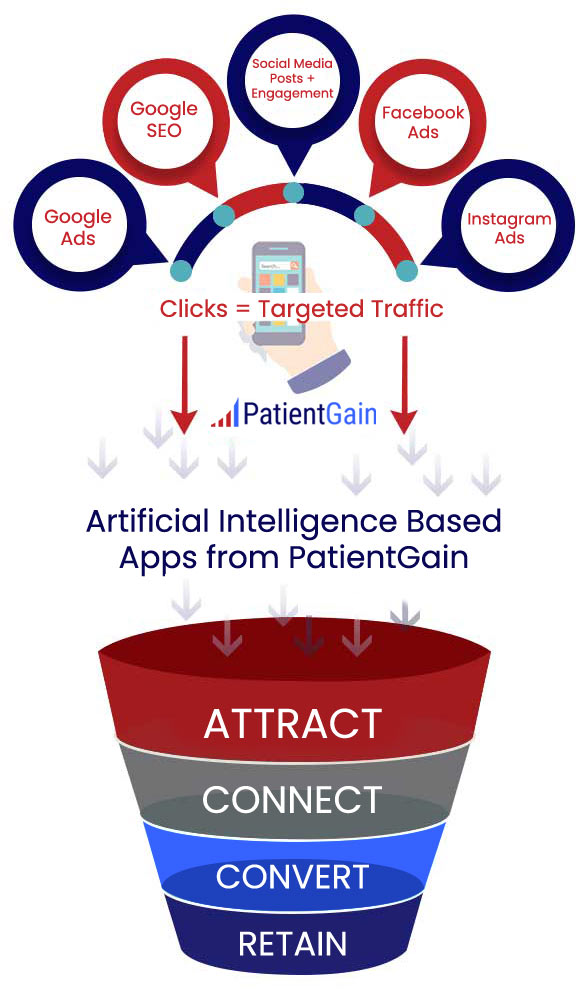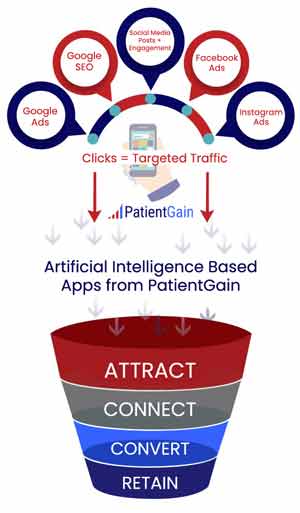Benefits of Hiring a Top Medical Marketing Company and Professional HIPAA Compliant Medical Marketing Company
Top-tier medical marketing companies excel through specialized industry knowledge, comprehensive service offerings, a focus on measurable results, and strong client communication. They understand the unique nuances of healthcare, including regulations and patient behaviors, and tailor their strategies accordingly. When a medical marketing company embodies these qualities, practices benefit from:
- Legally compliant, trustworthy messaging that protects reputation.
- Seamless, full-spectrum marketing campaigns that handle everything from SEO to paid ads and patient engagement.
- Clear visibility into marketing ROI with data-driven optimization.
- Dominance in local search results to attract geographically relevant patients.
- Strong online reputations that foster patient trust and referrals.
- Innovative technologies like AI based medical marketing automation that streamline operations.
- Ongoing transparent communication for effective collaboration.
- Proof of success that reassures providers of their investment.
- Ethical marketing that respects patients and builds lasting relationships.


What is considered a top medical marketing company?
- Provide your medical practice a clear competitive advantage in terms of marketing, advertising and technology
- Must have detailed knowelege about yoru practice and medical services offered by your practice
- Must be HIPAA compliant – HIPAA compliant for technology, staff and processes.
- Website development with A/B testing and proven conversion techniques
- Experience in helping multi-channel patient acquisition strategies
- Proven customer service and dedicated staff who get to know you by first name basis
- Live marketing dashboards – so your staff can see leads and data as it happens in real time.
- Alerts sent to your staff when is a new lead/referral/inquiry
- HIPAA compliant CRM should be included in your marketing funnel
By looking for these qualities and asking for specific examples of how a company embodies them, healthcare providers can make a more informed decision and choose a marketing partner truly equipped to help them succeed. Let’s expand on the top qualities of the best medical marketing companies with specific examples to illustrate what each quality looks like in practice. This should give you a clearer idea of what to expect and demand from a top-tier agency in 2025.
- Deep Healthcare Industry Expertise & Specialization:
- Beyond General Knowledge: They don’t just know “SEO”; they know “SEO for cardiologists” which includes understanding keywords like “arrhythmia specialist,” “interventional cardiology procedures,” or “signs of heart attack” versus SEO for a dermatology clinic focusing on “acne treatment,” “Botox,” or “skin cancer screening.”
- Understanding Patient Journeys: For an orthopedic practice, they understand a patient might search “knee pain when running,” then “non-surgical knee treatments,” then “best orthopedic surgeon for knee replacement [city].” They tailor content and touchpoints for each stage.
- Familiarity with Medical Terminology: They can create content about “laparoscopic cholecystectomy” that is accurate and also understandable to a layperson, without the medical practice having to heavily edit for clinical accuracy.
- Example: Instead of just suggesting “social media posts,” a specialized agency might recommend specific Facebook groups for new mothers for a pediatric practice, or professional LinkedIn strategies for a B2B medical device client.
- Profound Knowledge of Regulatory Compliance (HIPAA, FDA, etc.):
- HIPAA-Compliant Website Forms:
- Non-Compliant Example: A “Request an Appointment” form that emails unencrypted patient details (name, desired service like “depression counseling,” phone number) directly to a general office email.
- Compliant Example: The form submission is encrypted (HTTPS), data is stored securely, any email notification to the office is minimal (e.g., “New appointment request received – log in to secure portal to view”), and the agency has a Business Associate Agreement (BAA) with the practice.
- Ethical Patient Testimonials:
- Non-Compliant Example: Using a patient’s full name and a detailed story about their complex medical condition in a video testimonial without a comprehensive, signed HIPAA release form that specifically covers marketing use.
- Compliant Example: Obtaining explicit, written consent via a detailed HIPAA-compliant release form before using any patient story or image. They might also suggest anonymizing certain details if full PHI isn’t crucial for the testimonial’s impact.
- Advertising Claims:
- Non-Compliant Example: An ad for a cosmetic procedure that guarantees “you’ll look 10 years younger” without any disclaimers or typical results statements.
- Compliant Example: Ads use realistic imagery, state “results may vary,” and avoid definitive guarantees, focusing on benefits and the expertise of the providers, all while adhering to state medical board advertising rules.
- HIPAA-Compliant Website Forms:
- Proven Track Record and Measurable Results (Data-Driven Approach):
- Case Studies with Specific Metrics:
- Vague: “We increased website traffic for Dr. Smith.”
- Specific Example: “For ‘Main Street Cardiology,’ we implemented a local SEO and content strategy. Within 6 months, their organic website traffic increased by 150%, they achieved first-page Google rankings for 15 key local search terms (e.g., ‘best cardiologist [city]’), and new patient appointment requests from the website increased by 35%, resulting in an estimated ROI of 3:1 on their marketing spend.”
- Transparent Reporting:
- Poor: Occasional, confusing spreadsheets of numbers.
- Good Example: Monthly reports with clear dashboards showing website traffic sources, keyword ranking changes, conversion rates (e.g., how many website visitors completed an appointment request form), cost per lead from PPC campaigns, and online review sentiment analysis. They explain what the data means and what actions are being taken based on it.
- Case Studies with Specific Metrics:
- Comprehensive & Customized Service Offerings:
- Customized Strategy for a New Practice:
- Example: For a new dental practice, the initial strategy might heavily focus on hyper-local SEO (Google Business Profile optimization, local citations), a foundational website build with an emphasis on “meet the dentist” and “new patient offers,” and targeted Facebook ads to build initial awareness in the immediate zip codes.
- Customized Strategy for an Established Specialty Clinic Aiming for Regional Leadership:
- Example: For a well-regarded orthopedic group wanting to attract more complex surgical cases from a wider area, the strategy might involve developing in-depth content (articles, webinars) on advanced surgical techniques, targeted advertising to referring primary care physicians, building online reputation through peer endorsements, and optimizing for broader, condition-specific keywords.
- Customized Strategy for a New Practice:
- Strong Focus on Patient-Centric Content and Communication:
- Patient-Centric Content and Service Pages:
- Provider-Centric: “Our New MRI Machine.”
- Patient-Centric Example: “What to Expect During Your MRI: A Guide to Easing Anxiety and Understanding the Process.” Or, for a pediatrician: “Is Your Child’s Sniffle Just a Cold or Something More? When to Call the Doctor.”
- Empathetic Tone in Social Media:
- Clinical: “We offer flu shots. Call to book.”
- Patient-Centric Example: “Protect your family this flu season! Getting your flu shot is a simple step to keep everyone healthier. We know life is busy, so we offer convenient appointment times. Call us today – we’re here to answer your questions. #FluSeason #FamilyHealth #[PracticeName]”
- Website Content Addressing Patient Concerns: A fertility clinic’s website might have a detailed section on “Navigating the Emotional Journey of Fertility Treatment” with links to support resources, in addition to clinical information.
- Patient-Centric Content and Service Pages:
- Excellent Communication and Collaboration (Partnership Approach):
- Regular Scheduled Meetings:
- Example: Monthly or bi-weekly virtual meetings with a set agenda covering campaign performance, upcoming initiatives, addressing client questions, and gathering feedback on practice developments that might impact marketing (e.g., new services, new doctor joining).
- Proactive Updates:
- Example: The agency emails the client: “Just wanted to let you know that the new blog post on ‘Managing Seasonal Allergies in Children’ is live on your website and we’ve scheduled social media promotions for it. We’re already seeing some good initial engagement.”
- Shared Project Management Tools: Using platforms like Asana, Trello, or a dedicated client portal where the practice can see project timelines, approve content, and communicate with the agency team transparently.
- Regular Scheduled Meetings:
- Adaptability and Innovation:
- Adopting New Technologies:
- Example: Skillfully and ethically incorporating AI-powered tools for tasks like initial content brainstorming (always human-reviewed and edited for medical accuracy), analyzing large datasets for patient insights, or personalizing patient communication (e.g., AI-driven chatbots for initial website inquiries that are HIPAA-compliant and escalate to human staff when needed).
- Responding to Search Engine Algorithm Updates:
- Example: If Google releases a major update that prioritizes video content for certain medical queries, the agency proactively advises the client on developing a short video strategy for their key services, rather than waiting for rankings to drop.
- Exploring New Patient Engagement Channels: If a new, HIPAA-secure patient communication platform gains traction, they evaluate its potential for the practice.
- Adopting New Technologies:
- Clear Understanding of Local Market Dynamics:
- Targeted Local Content:
- Example: For a dermatology practice in a sunny state like Florida or California, creating blog content specifically about “Sun Protection Tips for [Local Beach Goers]” or “Recognizing Early Signs of Skin Cancer in [Specific Demographic Prevalent Locally].”
- Community Engagement Strategies:
- Example: Recommending and helping a pediatric practice sponsor a local youth sports team or participate in a community health fair, and then leveraging that participation for online content and social media engagement.
- Understanding Local Competition: Knowing which nearby hospitals or clinics are direct competitors for specific services and developing strategies to differentiate the client practice (e.g., highlighting shorter wait times, specialized technology, or a more personalized approach).
- Targeted Local Content:
By looking for these qualities and asking for specific examples of how an agency embodies them, healthcare practices can make a much more informed decision when choosing a medical marketing partner.
![Understanding Patient Journeys: For an orthopedic practice, they understand a patient might search "knee pain when running," then "non-surgical knee treatments," then "best orthopedic surgeon for knee replacement [city]." They tailor content and touchpoints for each stage. Understanding Patient Journeys: For an orthopedic practice, they understand a patient might search "knee pain when running," then "non-surgical knee treatments," then "best orthopedic surgeon for knee replacement [city]." They tailor content and touchpoints for each stage.](https://www.patientgain.com/wp-content/uploads/2025/01/abc-medspa-fb-ads-vid-desktop.gif)
![Understanding Patient Journeys: For an orthopedic practice, they understand a patient might search "knee pain when running," then "non-surgical knee treatments," then "best orthopedic surgeon for knee replacement [city]." They tailor content and touchpoints for each stage. Understanding Patient Journeys: For an orthopedic practice, they understand a patient might search "knee pain when running," then "non-surgical knee treatments," then "best orthopedic surgeon for knee replacement [city]." They tailor content and touchpoints for each stage.](https://www.patientgain.com/wp-content/uploads/2025/01/abc-medspa-fb-ads-vid-mobile.gif)
